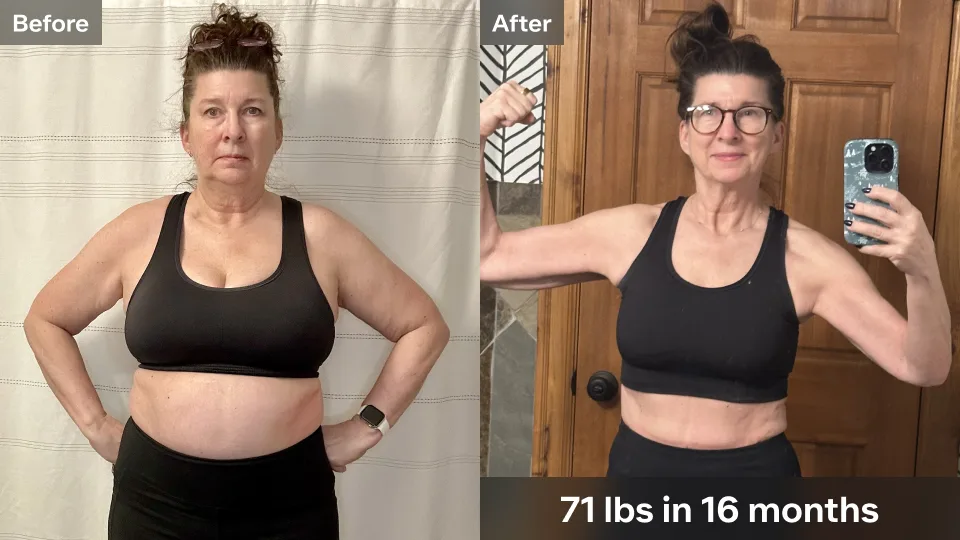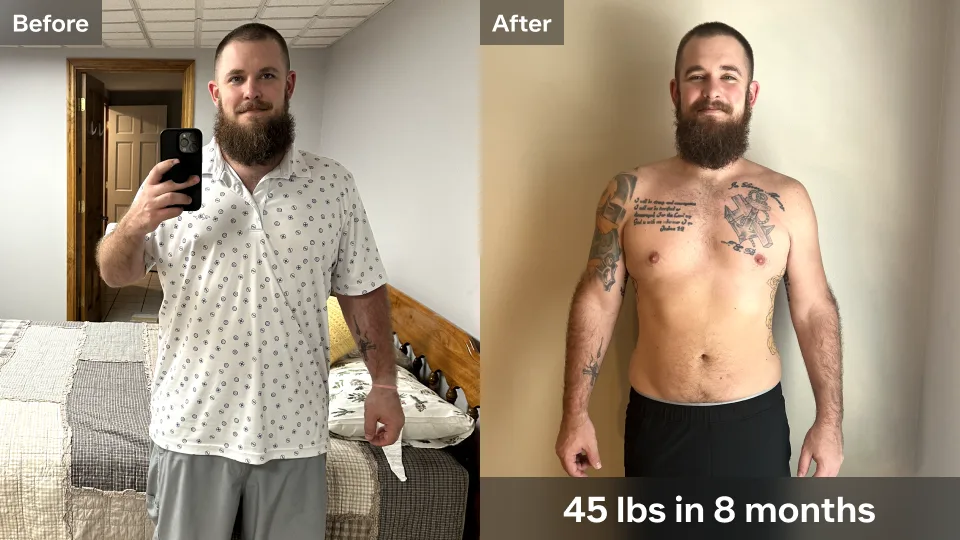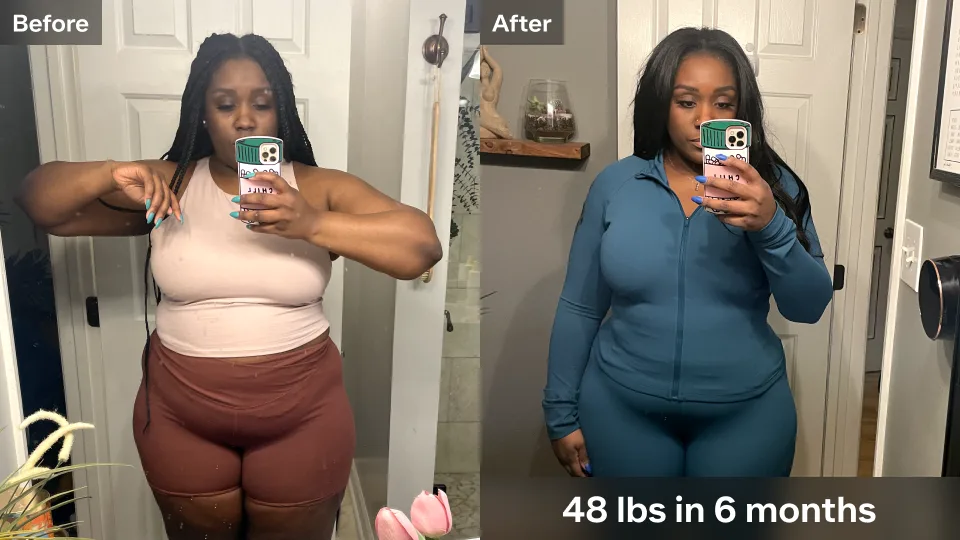Protein calculator for weight loss and muscle gain
This protein calculator estimates how much protein you need each day based on your current weight, activity level, and goals, giving you a clear starting point to help you lose weight or build muscle effectively.
Recommended protein intake
0 – 0
Grams/Day
0 – 0
Grams/Meal
This protein calculator gives a general estimate and isn't medical advice. Everyone's body is different. For guidance that’s tailored to your health and goals, it’s always best to speak with a healthcare provider.
How to use this protein calculator
How does protein help you lose weight?
How much protein should you eat to lose weight?
Can you eat too much protein?
How does protein help you build muscle?
How much protein do you need to build muscle?
Protein-to-calorie ratio for weight loss
Protein-to-calorie ratio to build muscle
Best protein sources for weight loss
High-protein snacks for weight loss
How to get 100 grams of protein a day
Ro weight loss and protein
How to use this protein calculator
Whether you want to lose weight, build muscle, or maintain your results, this protein calculator is designed to guide you toward your goals.
It factors in your current weight, goal, and activity level to provide a practical daily protein target to help you eat with intention and fuel your progress. Simply enter your details and hit “calculate.” In seconds, you’ll get a personalized protein goal in grams per day and grams per meal.
Including more protein in your diet can help you stay satisfied longer, lose weight, and build muscle when paired with regular exercise. Studies also show that your current body size can be a good starting point for determining your daily protein needs. That’s because it reflects the energy your body uses right now as you work toward your goals.
How to choose your goal
Your protein needs depend on what you’re working toward, which is why this protein calculator factors in your goal.
You have three options:
Lose weight, which gives you a protein target to support fat loss while helping you maintain or build muscle.
Maintain weight, which gives you a protein target to sustain energy, weight, and muscle over time.
Build muscle, which gives you a higher protein target to help your body recover and grow stronger.
How to choose your activity level
Your activity level helps fine-tune your protein target. The more active you are, the more protein your body needs to recover and maintain muscle.
Here’s a rough breakdown of the levels:
Sedentary: Little to no weekly exercise — mostly seated during work or daily activities.
Light: One to two days per week of low-intensity movement, such as casual walking, stretching, or gentle yoga.
Moderate: Three to five days per week of moderate activity, such as brisk walking, cycling, or consistent gym workouts.
Active: Five to six days per week of structured training or physically demanding work.
Very active: Intense exercise almost every day, often combining cardio and strength training.
Extremely active: High-volume or competitive-level training once or twice daily. (Protein needs are highest for recovery and performance.)
If you’re between two levels, choose the one that feels closest to your average week. You can always adjust your activity level as your routine changes.
Determining your activity level can also help you calculate your TDEE (total daily energy expenditure). This number estimates how many calories you burn in a day, and can help guide healthy weight loss goals.
How does protein help you lose weight?
Eating more protein can support weight loss in several meaningful ways. And understanding how it works can help you use your protein target more effectively.
According to research, protein can:
Help you feel fuller longer
Reduce appetite
Cut down cravings
Boost calorie burn
Preserve muscle while losing fat
Build muscle
Protein helps you feel fuller for longer, reduces cravings, and curbs appetite — all of which can make it easier to eat less overall. This natural reduction in calorie intake supports the calorie deficit needed for weight loss. You can use a calorie calculator or speak to a dietitian to determine how many fewer calories you need to eat daily to achieve your weight loss goals.
Protein’s role in preserving and building lean muscle mass can also boost your basal metabolic rate (BMR), which is the number of calories your body burns at rest. A higher BMR means your body burns more calories throughout the day, even when you’re not exercising.
This effect can be especially helpful if you’re losing weight quickly, such as while taking a GLP-1 medication. Preserving muscle mass helps maintain a healthy metabolism, keeping your body burning calories efficiently even as the number on the scale drops.
Protein doesn’t just play a role in weight loss; it supports nearly every major system in the body. The nutrient is essential for supporting immune function, regulating hormones, and repairing tissues throughout the body, among other functions.
How much protein should you eat to lose weight?
Research shows that most people need 1.2–1.6 grams of protein per kilogram of body weight per day to lose weight effectively while preserving lean muscle mass.
For example, someone who weighs 150 pounds (68 kg) would need about 80–110 grams of protein per day to support healthy weight loss.
By comparison, the general daily recommendation for adults is 0.8 grams of protein per kg of body weight, according to the Dietary Guidelines for Americans.
Using that guideline, the same 150-pound person would only need about 55 grams per day. When weight loss is the goal, however, aiming for 50%--100% more protein than the standard baseline can help protect muscle and keep your metabolism strong.
Getting more protein during weight loss matters because it helps your body burn fat while holding onto lean muscle, which keeps your metabolism active. Without enough protein, your body may begin to break down muscle for energy, making weight loss harder to sustain over time.
The exact amount of protein you need for weight loss depends on your body composition, lifestyle, activity level, and goals.
If you work out regularly or lift weights, you may benefit from up to 2 grams of protein per kg of body weight per day to support recovery and muscle growth.
If you’re using a GLP-1 medication or following a lower-calorie plan, you might also aim for the higher end of the 1.2–1.6 grams of protein per kg of body weight per day range to protect muscle as you lose fat.
The protein calculator result gives you a personalized number — a realistic daily target based on your current weight, activity level, and goals — so you can focus on losing fat while maintaining strength and muscle.
Can you eat too much protein?
Yes, it’s possible to eat too much protein. But for most healthy adults, it’s not usually something you need to worry about.
So, how much protein is too much?
Research has found that daily intakes up to 2–2.2 grams of protein per kg of body weight are considered safe for people with normal kidney function. Even at the higher end of that range, studies haven’t found harmful effects on kidney, liver, or bone health in otherwise healthy adults.
Potential problems are more likely when protein intake regularly exceeds 3–4 grams per kg of body weight per day, especially without drinking enough fluids or in people with preexisting kidney issues. At those levels, the body can’t efficiently use the excess protein for muscle growth or energy, and it offers no additional benefit for weight loss or strength.
For most people, eating 1.2–2 grams of protein per kg of body weight per day is both safe and effective. That range can support weight management, muscle maintenance, and overall health — without approaching the “too much” mark.
If you have kidney disease or another condition that affects how your body processes protein, it’s best to talk with a healthcare provider before making major dietary changes.
For otherwise healthy adults, the goal should be getting enough protein consistently without overdoing it. Remember, your body needs a balance of other nutrients — including carbohydrates, fats, vitamins, and minerals — to function optimally and support overall health.
How does protein help you build muscle?
Protein is the foundation of muscle growth. Getting enough of it — and spreading intake throughout the day — can help you train harder, recover faster, and see more strength and definition over time.
According to research, protein helps:
Kick-start muscle repair and growth
Support recovery after workouts
Improve strength and performance
Reduce soreness and muscle breakdown
Preserve lean mass during calorie restriction
When you exercise, your muscles experience small amounts of stress and damage — that’s what stimulates growth. Protein supplies your body with the amino acids (building blocks) it needs to repair and rebuild those muscle fibers so they come back stronger.
Studies show that consuming 20–40 grams of high-quality protein after resistance training can maximize muscle protein synthesis, the process that drives muscle repair and growth. Over time, this leads to increases in both muscle mass and strength.
Protein also supports recovery by reducing post-workout soreness and helping your body adapt more efficiently to training. In other words, it helps you bounce back faster after challenging sweat sessions so you can stay consistent and continue to get those gains.
Even when you’re eating fewer calories overall, eating enough protein can help protect your existing muscle so you maintain tone and strength.
How much protein do you need to build muscle?
Whether the goal is to lose weight or build muscle, how much protein you need varies from person to person.
That said, research suggests that 1.6–2.2 grams of protein per kg of body weight per day is the sweet spot for supporting muscle growth when paired with regular resistance training. That’s at least twice the general daily recommendation for adults.
And for our 150-pound person? This translates to roughly 110–150 grams of protein per day.
So, why do you need so much more protein to build muscle? Because strength training creates tiny tears in your muscle fibers, and protein provides the amino acids needed to repair and rebuild them.
Consistently getting enough protein helps tip the balance toward muscle growth rather than muscle breakdown, leading to stronger, leaner results over time.
Your protein needs can vary depending on training intensity, age, and calorie intake:
Beginners and older adults may benefit from the higher end of the range (around 2.0–2.2 grams per kg) to stimulate muscle growth.
Regular lifters or athletes can often maintain progress at 1.6–1.8 grams per kg, as long as total calories and timing stay consistent.
During calorie deficits, aiming for the higher end can help preserve muscle while losing fat.
Spreading protein evenly across the day also matters. Research shows that having 20–40 grams of protein during each meal maximizes muscle repair and growth and is better than consuming all of your intended protein in one sitting.
Protein-to-calorie ratio for weight loss
There’s no official guideline for an exact protein-to-calorie ratio for weight loss. But research suggests that protein should make up about 25%–30% of your daily calories if you’re trying to lose fat while maintaining muscle.
For example, if you’re eating around 1,600 calories a day, aim for roughly 400-480 calories from protein.
That’s quite a bit higher than the general recommendation of 10%–15% for the average adult. But research shows that a higher-protein diet is more effective for fat loss, appetite control, and muscle maintenance, especially when combined with regular exercise and a calorie deficit.
Protein-to-calorie ratio to build muscle
There’s no rule for how much of your total calories should come from protein when building muscle. But most studies recommend 1.6–2.2 grams of protein per kg of body weight per day to support muscle growth when paired with strength training.
Depending on your total calorie intake, that typically works out to roughly 15%–25% of daily calories from protein.
So, if you’re eating 1,600 calories, you may try to aim to get around 240–400 calories from protein.
It’s important to remember that consistency matters more than precision. Hitting your daily protein target — generally around 1.6–2.2 grams per kg of body weight — is what truly drives muscle growth and maintenance, not the exact ratio itself.
Making a conscious effort to include adequate protein as part of a balanced diet and healthy lifestyle will move you closer to your goals than worrying too much about specific numbers.
Best protein sources for weight loss
Protein-rich foods help you stay full, preserve muscle, and support a healthy metabolism. And when it comes to weight loss, it’s especially key to choose options low in fat and added sugar.
Here are some lean, high-protein foods and approximately how much protein they provide per 100 grams, according to the USDA’s FoodData Central:
Chicken breast (cooked, skinless): 31 grams of protein
Turkey breast (cooked, skinless): 30 grams of protein
Salmon (cooked): 22 grams of protein
Tofu (firm): 10 grams of protein
Edamame (boiled): 11 grams of protein
Lentils (cooked): 9 grams of protein
Eggs (whole, cooked): 13 grams of protein
High-protein snacks for weight loss
Smart snacking can help you stay on track between meals and keep hunger in check. Choose snacks that combine convenience with a solid hit of protein to stay satisfied longer.
Greek yogurt
Hard-boiled eggs
Roasted edamame or chickpeas
Protein shake or smoothie
Minimally processed beef or turkey jerky
Mixed nuts
Just remember to steer clear of added sodium, sugar, and saturated fats — all of which could derail your weight loss progress.
How to get 100 grams of protein a day
Getting 100 grams of protein a day doesn’t have to mean eating chicken for breakfast, lunch, and dinner. With a few simple habits, you can hit your target without overthinking it.
Include protein at every meal: Aim for a palm-sized portion of protein-rich food at every meal.
Plan ahead: Keep ready-to-eat options and snacks like hard-boiled eggs or tuna packs on hand for busy days.
Mix up your sources: Rotate between lean meats, seafood, eggs, beans, tofu, lentils, and edamame for variety and balance.
Add small boosts: Stir protein powder into smoothies, sprinkle nuts and seeds onto salads, or choose high-protein snacks to round out your day.
Ro weight loss and protein
Eating enough protein can make weight loss easier — it helps control hunger, preserve muscle, and keep your metabolism strong. But every weight loss journey is different, and sometimes reaching your goals takes more than nutrition alone. That’s where Ro’s weight loss offerings come in.
The Ro Body membership makes clinically guided weight loss more accessible and sustainable. It combines FDA-approved GLP-1 medications like Wegovy and Zepbound with ongoing care from licensed providers, 1:1 health coaching, and app-based tools for tracking progress (if treatment is appropriate).
Members also receive insurance support, monthly check-ins, and ongoing guidance to help build lasting habits for better health. To see if Ro’s program is a good fit for you, start by completing our quick questionnaire and go from there. (You can get $100 off your first month, too.)
References
Dekker, I. M., van Rijssen, N. M., Verreijen, A., Weijs, P. J., de Boer, W. B. E., Terpstra, D., & Kruizenga, H. M. (2022). Calculation of protein requirements; a comparison of calculations based on bodyweight and fat free mass. Clinical nutrition ESPEN, 48, 378–385. doi:10.1016/j.clnesp.2022.01.014. Retrieved from https://pubmed.ncbi.nlm.nih.gov/35331517/
Geisler, C., Prado, C. M., & Müller, M. J. (2016). Inadequacy of Body Weight-Based Recommendations for Individual Protein Intake-Lessons from Body Composition Analysis. Nutrients, 9(1), 23. doi:10.3390/nu9010023. Retrieved from https://pmc.ncbi.nlm.nih.gov/articles/PMC5295067/
Jäger, R., Kerksick, C. M., Campbell, B. I., Cribb, P. J., Wells, S. D., Skwiat, T. M., Purpura, M., Ziegenfuss, T. N., Ferrando, A. A., Arent, S. M., Smith-Ryan, A. E., Stout, J. R., Arciero, P. J., Ormsbee, M. J., Taylor, L. W., Wilborn, C. D., Kalman, D. S., Kreider, R. B., Willoughby, D. S., Hoffman, J. R., … Antonio, J. (2017). International Society of Sports Nutrition Position Stand: protein and exercise. Journal of the International Society of Sports Nutrition, 14, 20. doi:10.1186/s12970-017-0177-8. Retrieved from https://jissn.biomedcentral.com/articles/10.1186/s12970-017-0177-8%E2%80%8C
LaPelusa, A., Kaushik, R. Physiology, Proteins. (2022). StatPearls. Retrieved from https://www.ncbi.nlm.nih.gov/books/NBK555990/
Leidy H. J. (2014). Increased dietary protein as a dietary strategy to prevent and/or treat obesity. Missouri medicine, 111(1), 54–58. Retrieved from https://pmc.ncbi.nlm.nih.gov/articles/PMC6179508/
Leidy, H. J., Clifton, P. M., Astrup, A., Wycherley, T. P., Westerterp-Plantenga, M. S., Luscombe-Marsh, N. D., Woods, S. C., & Mattes, R. D. (2015). The role of protein in weight loss and maintenance. The American journal of clinical nutrition, 101(6), 1320S–1329S. doi:10.3945/ajcn.114.084038. Retrieved from https://www.sciencedirect.com/science/article/pii/S0002916523274274
Moon, J., & Koh, G. (2020). Clinical Evidence and Mechanisms of High-Protein Diet-Induced Weight Loss. Journal of obesity & metabolic syndrome, 29(3), 166–173. doi:10.7570/jomes20028. Retrieved from https://pmc.ncbi.nlm.nih.gov/articles/PMC7539343/
Morton, R. W., Murphy, K. T., McKellar, S. R., Schoenfeld, B. J., Henselmans, M., Helms, E., Aragon, A. A., Devries, M. C., Banfield, L., Krieger, J. W., & Phillips, S. M. (2018). A systematic review, meta-analysis and meta-regression of the effect of protein supplementation on resistance training-induced gains in muscle mass and strength in healthy adults. British journal of sports medicine, 52(6), 376–384. doi:10.1136/bjsports-2017-097608. Retrieved from https://pubmed.ncbi.nlm.nih.gov/28698222/
Ogilvie, A. R., Schlussel, Y., Sukumar, D., Meng, L., & Shapses, S. A. (2022). Higher protein intake during caloric restriction improves diet quality and attenuates loss of lean body mass. Obesity (Silver Spring, Md.), 30(7), 1411–1419. doi:10.1002/oby.23428. Retrieved from https://pubmed.ncbi.nlm.nih.gov/35538903/
Tinsley, G. M., & Nadolsky, S. (2025). Preservation of lean soft tissue during weight loss induced by GLP-1 and GLP-1/GIP receptor agonists: A case series. SAGE open medical case reports, 13, 2050313X251388724. doi:10.1177/2050313X251388724. Retrieved from https://pmc.ncbi.nlm.nih.gov/articles/PMC12536186/
Trommelen, J., Betz, M. W., & van Loon, L. J. C. (2019). The Muscle Protein Synthetic Response to Meal Ingestion Following Resistance-Type Exercise. Sports medicine (Auckland, N.Z.), 49(2), 185–197. doi:10.1007/s40279-019-01053-5. Retrieved from https://link.springer.com/article/10.1007/s40279-019-01053-5
U.S. Department of Agriculture & U.S. Department of Health and Human Services. (2020). Dietary Guidelines for Americans 2020–2025 (9th ed.). Retrieved from https://www.dietaryguidelines.gov/
Wu G. (2016). Dietary protein intake and human health. Food & function, 7(3), 1251–1265. doi:10.1039/c5fo01530h. Retrieved from https://pubmed.ncbi.nlm.nih.gov/26797090/
Meet our expert
When it comes to weight loss, biology is your nemesis. Not willpower. Our very own Dr. Steve explains why.
Thousands of members and counting
Real members, real weight loss results
Don't just take it from us—our members see (and feel) the difference. These members were paid in exchange for their testimonials.
87% have seen life-changing results*
93% agree Ro is easier to incorporate into their lives*
97% report silenced or quieter food noise since starting*
Average weight loss in 1 year is 15-20% (vs 2.4-3.1% with diet and exercise alone). Based on studies of branded medications in non-diabetics with obesity, or with overweight plus a weight-related condition, with diet and exercise.
*Based on survey results of 1,243 Ro members taking GLP-1 medication for at least 7 weeks, paired with diet and exercise.
A full suite of GLP-1 weight loss medications
Zepbound and Wegovy are FDA-approved for weight loss. Ozempic is FDA-approved for type 2 diabetes treatment, but may be prescribed off-label for weight loss at a healthcare provider’s discretion.






